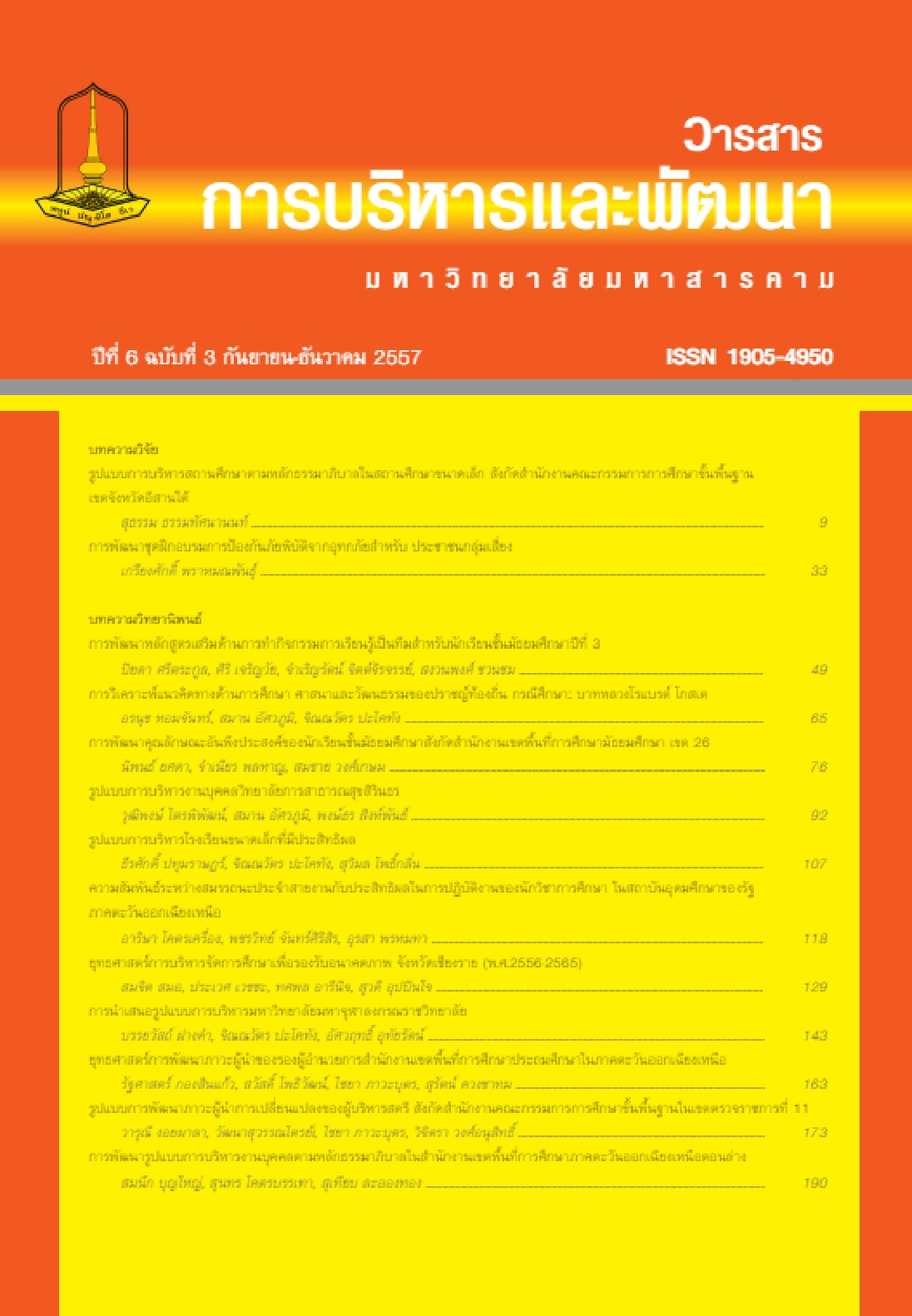A Development of the Enrichment Curriculum on Acting the tema Learning Activities for Mathayomsuksa3 Students.
Main Article Content
Abstract
The purposes of the study were to construct the enrichment curriculum on acting the team learning activities for Mattayomsuksa 3 students and to search the effectiveness of the enrichment curriculum acting on the team learning activities. The 4 procedures of development were: 1) Studying to set the curriculum structures by summarizing, concepts, principles, theories, the related researches; and interviewing, 2) Forming the enrichment curriculum as the structures setted, 3) Considering the appropriation of the enrichment curriculum by presenting to the 9 experts by means of group discussion, and 4) Checking the effectiveness of the enrichment curriculum by implementing with 30 Mattayomsuksa 3 students for 30 hours. The research tools used for collecting data were: 1) Knowledge Test, 2) Competency Test on Team Learning Activity and 3) Questionnaire for Students’ Satisfaction on Team Learning Activity. The data were analyzed by the computer program.
The research findings were two fold as follows: Firstly, The enrichment curriculum acting on the team learning activities for Mattayomsuksa 3 students consisted of two parts: Past 1: The enrichment curriculum consisted of 6 components as: 1. The principle of enrichment curriculum related to type, characteristic and content; 2. The objectives of enrichment curriculum were: (1) to provide students with knowledge, understanding and benefits of team-based learning activity, (2) to enable students for efficient applying knowledge, skills and experiences of team-based learning activity to their daily lives, (3) to make students have their satisfactions on team-based learning activity; 3. The contents of enrichment curriculum were obtained from teachers and students interviewing consisted of 4 learning objects as: (1) Team reporting, (2) Team meeting, (3) School survey and, (4) Community study; 4. The team-based learning activity was conducted by providing students with learning activities, group discussions, suggestions and team activities via work sheets; 5. Learning media were used in activities to make learners having their clear view and understanding in all contents that the researcher divided them in accordance with lesson plans as before, during and after activities and; 6. Learning achievements were measured and evaluated by (1) Knowledge Test, (2) Competency Test on Team Learning Activity and (3) Questionnaire for Students’ Satisfaction on Team Learning Activity. And Part 2: The four learning activity plans as: Learning activity plan on team reporting, Learning activity plan on team meeting, Learning activity plan on school survey and, Learning activity plan on community study. Each group of student had to comply with 4 steps of working component as follows; Step 1 – Planning, Step 2 – Sharing, Step 3 – Utilization and Step 4 – Evaluation. Secondly, The effectiveness of the enrichment curriculum on acting the team learning activities revealed that one, the students’ knowledge on acting as team learning activities was higher than after being taught 87.17%. Two, Ability: the students’ abilities on the team learning activities were rated as high level (X=4.49). And three, The students satisfaction towards acting the team learning activities was found to be the most level (X=4.53).
Downloads
Article Details
References
Atchara Chaiwiwat. (2008). The Development of the Enrichment Curriculum on the Critical Thinking Skills for Prathomsuksa 6 Students in Basic Education Schools. Journal of Education, Burapha University. 19(3): 65-66.
Aukkapong Sukkmart (2010). Development of Enrichment Curriculum to EnhanceDesirable Characteristics of
Prathomsuksa 4 Students via Contemplative Education. Dissertation in Education (Curriculum Research and Development): Graduate School, Srinakharinwirot University.
Beauchamp, G. A. (1975). Curriculum Theory. The 3rd Edition. Wilmetter, IL: The Kagg Press.
Johnson, D.W., and Johnson, R. T. (2005). Teaching Students to Be Peacemakers. The 4th Edition. Edina, MN: Interaction Book Company.
Office of the National Education Commission. (2002). National Education Act B.E. 2545 (1999) and Amendment (No.2) B.E. 2545 (2003). Bangkok: Prik Wan Graphic.
Office of the National Education Commission. (2011). Education Reform for the 21st Century to Ensure Leadership in the Information and Globalization Era. Bangkok: Office of the Prime Minister.
. (2012). The 11th National Economic and Social Development Plan B.E. 2555-2559 (2012-2016). Bangkok: Kurusapa Ladprao Printing.
Ornstein, A.G., and Hunkins,F.P. (2004). Curriculum Foundations, Principles and Issuses. New York: Pearson Education.
Pinsuda Sirirungsri. (2009). Thai Educational Image for the Future of 10-20 Years. Bangkok: Pim Dee Printing.
Pitsanu Fongsri. (2006). Educational Evaluation: Concept to Practice. The 2nd Edition. Bangkok: Tiam Fa Prining.
Saylor, Galen J.; and Alexander, William M. (1981). Planning Curriculum for School. New York: Holt, Rinehart and Winston.
Sunee Phoopun. (2003). Basic Concept on Curriculum Creating and Development. Chiang Mai: Chiang Mai Saeng Silp Publishing.
Taba, H. (1962). Curriculum Development Theory and Practice. New York: Harcourt, Brace & World.
Tisana Khammani. (2002). Group Dynamics for Working and Learning Management. Bangkok: Nishin Advertising Group.
Worapot Wongkitcharoen and Atip Jittrerk. (2011). Education for the 21st Century. Bangkok: Open Worlds Publishing.


